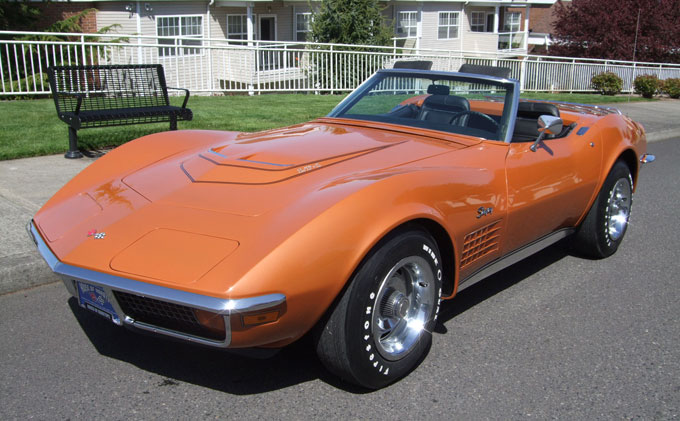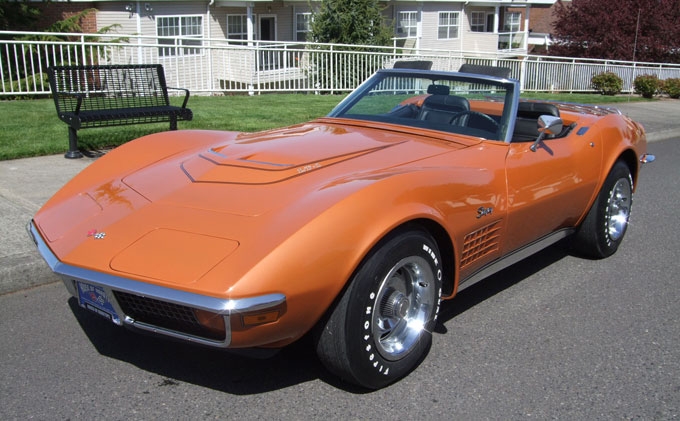
One of 1,741 produced, this is a Corvette 350/255 LT-1 with original, matching-numbers M21 4-speed. Also features Positraction, power steering, tilt/telescopic column, leather, factory AM/FM radio, two tops and Ontario Orange exterior with original rally wheels.
This was the last year for the mighty LT-1, and this is one of only 1,741 coupes and convertibles produced. This is a fascinating Ontario Orange LT-1 Corvette that spent nearly its entire life in The Dalles, OR, just 80 miles east of Portland, OR.
This car was built in June 1972, and it is a beautifully restored factory LT-1 Corvette.
SCM Analysis
Detailing
This car, Lot 375.1, sold for $38,500, including buyer’s premium, at Barrett-Jackson’s Orange County sale on Sunday, June 26, 2011.
In 1972, the top song on American airways was Don McLean’s epic “American Pie,” which mournfully challenged the optimism of American culture and psyche of the 1950s and early 1960s. McLean’s song was a defining moment in the American experience—something had been lost, and we knew it. The song’s chorus includes the lyric: “…Drove my Chevy to the levee, but the levee was dry…” In many ways, it was Chevy performance which was quickly running dry.
The Corvette faithful, who wanted the ascent in performance to continue unabated, knew times were changing for the Corvette—and not for the better.
Losing power, torque and glamour
The 1972 LT-1 engine was the last solid-lifter small block to bless a Corvette. The original LT-1 engine was offered in 1970, with a compression ratio of 11:1, which produced 370 horsepower at 6,000 rpm, along with 380 foot-pounds of torque at 4,000 rpm. In 1971, to comply with new federal emissions requirements, the compression ratio was reduced to 9.0:1, producing 330 horsepower at 5,600 rpm and 360 foot-pounds of torque at 4,000 rpm.
In 1972, the automotive industry switched from using Society of Automotive Engineers (SAE) gross horsepower ratings to SAE net horsepower ratings, and the 1972 LT-1 dropped to an official rating of 255 horsepower at 5,600 rpm and 280 foot-pounds of torque at 4,000 rpm.
However, the 1971 and 1972 LT-1 engines offered the exact same performance.
This was the end of the run for the acclaimed “mouse that roared,” as Zora Arkus-Duntov proudly referred to the 350 LT-1 engine. It also signaled the end of an era in Corvette small-block performance breakthroughs. It would take until 1992 for Chevrolet to put a more powerful small-block V8 engine in the Corvette. Interestingly, the 1992 350/300 engine would be named LT1.
Look at the 5th digit
The 1970-72 LT-1 Corvettes, with their legendary performance and relatively low production numbers, are highly sought after by those drawn to early C3 styling and small-block-performance. This appeal—and consequent market value of the LT-1 Corvette—has made documentation a critical issue.
In 1970 and 1971, the primary documentation would be the Protect-O-Plate and Tank Sheet, which are too often missing, or even worse, frauds. In 1972, Chevrolet decided to include engine identification in the VIN. If the 5th digit is an L, as it is on this car, the Corvette started life with an LT-1 engine. This takes away a lot of the concern when establishing the authenticity of a 1972 LT-1 Corvette. Our car is the real deal.
This 1972 Ontario Orange LT-1 convertible was well bought. This classic convertible was nicely restored to factory-original appearance, with the exception of the missing smog pump. In its period-popular Ontario Orange (the exterior color most selected in 1972), this LT-1 roadster can be proudly and enthusiastically driven and enjoyed. The LT-1 Corvettes will always have a strong following among Corvette aficionados who understand the significance of the LT-1 engine in the development of the Corvette
